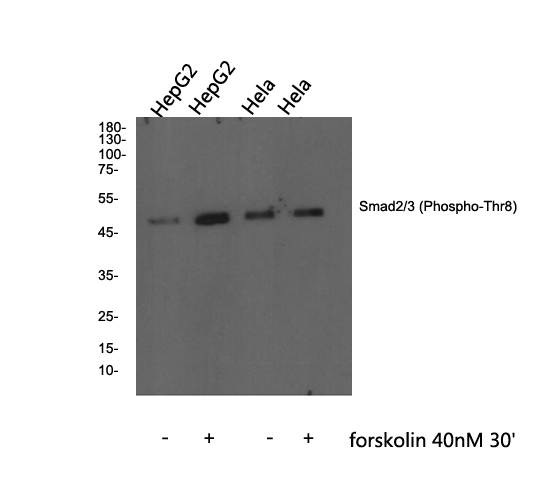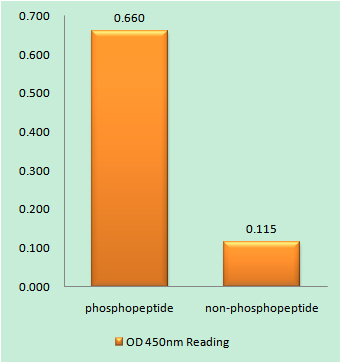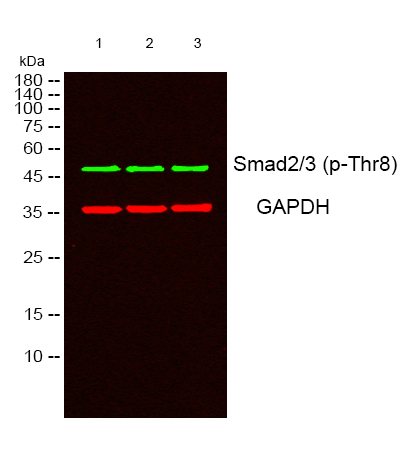Smad2/3 (phospho Thr8) Polyclonal Antibody
- Catalog No.:YP0362
- Applications:WB;IF;ELISA
- Reactivity:Human;Mouse;Rat;Pig
- Target:
- Smad2/3
- Fields:
- >>Cell cycle;>>Endocytosis;>>Cellular senescence;>>TGF-beta signaling pathway;>>Apelin signaling pathway;>>Hippo signaling pathway;>>Signaling pathways regulating pluripotency of stem cells;>>Th17 cell differentiation;>>Relaxin signaling pathway;>>AGE-RAGE signaling pathway in diabetic complications;>>Chagas disease;>>Human T-cell leukemia virus 1 infection;>>Pathways in cancer;>>Proteoglycans in cancer;>>Colorectal cancer;>>Pancreatic cancer;>>Hepatocellular carcinoma;>>Gastric cancer;>>Inflammatory bowel disease;>>Diabetic cardiomyopathy
- Gene Name:
- SMAD2/SMAD3
- Protein Name:
- Mothers against decapentaplegic homolog 2/3
- Human Gene Id:
- 4087/4088
- Human Swiss Prot No:
- Q15796/P84022
- Mouse Gene Id:
- 17126/17127
- Rat Gene Id:
- 29357/25631
- Rat Swiss Prot No:
- O70436/P84025
- Immunogen:
- The antiserum was produced against synthesized peptide derived from human Smad2/3 around the phosphorylation site of Thr8. AA range:1-50
- Specificity:
- Phospho-Smad2/3 (T8) Polyclonal Antibody detects endogenous levels of Smad2/3 protein only when phosphorylated at T8.
- Formulation:
- Liquid in PBS containing 50% glycerol, 0.5% BSA and 0.02% sodium azide.
- Source:
- Polyclonal, Rabbit,IgG
- Dilution:
- WB 1:500-2000; IF ICC 1:100-500;ELISA 1:5000-20000
- Purification:
- The antibody was affinity-purified from rabbit antiserum by affinity-chromatography using epitope-specific immunogen.
- Concentration:
- 1 mg/ml
- Storage Stability:
- -15°C to -25°C/1 year(Do not lower than -25°C)
- Other Name:
- SMAD2;MADH2;MADR2;Mothers against decapentaplegic homolog 2;MAD homolog 2;Mothers against DPP homolog 2;JV18-1;Mad-related protein 2;hMAD-2;SMAD family member 2;SMAD 2;Smad2;hSMAD2;SMAD3;MADH3;Mothers against decapentaplegic
- Observed Band(KD):
- 48kD
- Background:
- The protein encoded by this gene belongs to the SMAD, a family of proteins similar to the gene products of the Drosophila gene 'mothers against decapentaplegic' (Mad) and the C. elegans gene Sma. SMAD proteins are signal transducers and transcriptional modulators that mediate multiple signaling pathways. This protein mediates the signal of the transforming growth factor (TGF)-beta, and thus regulates multiple cellular processes, such as cell proliferation, apoptosis, and differentiation. This protein is recruited to the TGF-beta receptors through its interaction with the SMAD anchor for receptor activation (SARA) protein. In response to TGF-beta signal, this protein is phosphorylated by the TGF-beta receptors. The phosphorylation induces the dissociation of this protein with SARA and the association with the family member SMAD4. The association with SMAD4 is important for the translocation
- Function:
- disease:Defects in SMAD2 are found in sporadic cases of colorectal carcinoma.,function:Transcriptional modulator activated by TGF-beta and activin type 1 receptor kinase. SMAD2 is a receptor-regulated SMAD (R-SMAD). May act as a tumor suppressor in colorectal carcinoma.,PTM:Acetylated on Lys-19 by coactivators in response to TGF-beta signaling, which increases transcriptional activity. Isoform short: Acetylation increases DNA binding activity in vitro and enhances its association with target promoters in vivo.,PTM:In response to TGF-beta, ubiquitinated by NEDD4L; which promotes its degradation.,PTM:Phosphorylated on one or several of Thr-220, Ser-245, Ser-250, and Ser-255. In response to TGF-beta, phosphorylated on Ser-465/467 by TGF-beta and activin type 1 receptor kinases. Able to interact with SMURF2 when phosphorylated on Ser-465/467, recruiting other proteins, such as SNON, for degr
- Subcellular Location:
- Cytoplasm . Nucleus . Cytoplasmic and nuclear in the absence of TGF-beta. On TGF-beta stimulation, migrates to the nucleus when complexed with SMAD4 (PubMed:9865696, PubMed:21145499). On dephosphorylation by phosphatase PPM1A, released from the SMAD2/SMAD4 complex, and exported out of the nucleus by interaction with RANBP1 (PubMed:16751101, PubMed:19289081). Localized mainly to the nucleus in the early stages of embryo development with expression becoming evident in the cytoplasm at the blastocyst and epiblast stages (By similarity). .
- Expression:
- Expressed at high levels in skeletal muscle, endothelial cells, heart and placenta.
Cancer-associated fibroblasts-mediated ATF4 expression promotes malignancy and gemcitabine resistance in pancreatic cancer via the TGF-β1/SMAD2/3 pathway and ABCC1 transactivation. Cell Death & Disease Cell Death Dis. 2021 Mar;12(4):1-14 WB Human 1:1000 PANC-1 cell,BxPC-3 cell
SALL1 regulates commitment of odontoblast lineages by interacting with RUNX2 to remodel open chromatin regions. STEM CELLS Stem Cells. 2021 Feb;39(2):196-209 WB Mouse 1:1000 Mouse dental papilla cells (mDPCs)
Inhibin B suppresses anoikis resistance and migration through the transforming growth factor‐β signaling pathway in nasopharyngeal carcinoma. CANCER SCIENCE Cancer Sci. 2018 Nov;109(11):3416-3427 WB Human HNE1 cell, 5-8F cell
Branched Chain Amino Acids Protects Rat Mesangial Cells from High Glucose by Modulating TGF-β1 and BMP-7. Diabetes Metabolic Syndrome and Obesity-Targets and Therapy Diabet Metab Synd Ob. 2019; 12: 2433–2440 IF Rat 1:50 RMCs
Pan, Ming-Ming, et al. "Inhibition of TGF-β1/Smad signal pathway is involved in the effect of Cordyceps sinensis against renal fibrosis in 5/6 nephrectomy rats." Food and chemical toxicology 58 (2013): 487-494.
Amelioration of Lung Fibrosis by Total Flavonoids of Astragalus via Inflammatory Modulation and Epithelium Regeneration AMERICAN JOURNAL OF CHINESE MEDICINE Min Li WB Human,Mouse lung tissues A549 cells
Decorin inhibits the formation of hard nodules after microwave ablation by inhibiting the TGF-β1/SMAD and MAPK signaling pathways: in a Bama miniature pig model of mammary gland hyperplasia INTERNATIONAL JOURNAL OF HYPERTHERMIA Wei Zhang WB Pig mammary glands
2-Dodecyl-6-Methoxycyclohexa-2, 5-Diene-1, 4-Dione isolated from Averrhoa carambola L. root inhibits high glucose-induced EMT in HK-2 cells through targeting the regulation of miR-21–5p/Smad7 signaling pathway BIOMEDICINE & PHARMACOTHERAPY Jingyi Li WB,IF Human 1:1000,1:200 HK-2 cell
- June 19-2018
- WESTERN IMMUNOBLOTTING PROTOCOL
- June 19-2018
- IMMUNOHISTOCHEMISTRY-PARAFFIN PROTOCOL
- June 19-2018
- IMMUNOFLUORESCENCE PROTOCOL
- September 08-2020
- FLOW-CYTOMEYRT-PROTOCOL
- May 20-2022
- Cell-Based ELISA│解您多样本WB检测之困扰
- July 13-2018
- CELL-BASED-ELISA-PROTOCOL-FOR-ACETYL-PROTEIN
- July 13-2018
- CELL-BASED-ELISA-PROTOCOL-FOR-PHOSPHO-PROTEIN
- July 13-2018
- Antibody-FAQs
- Products Images
.jpg)
- Wei, L., Lin, Q., Lu, Y. et al. Cancer-associated fibroblasts-mediated ATF4 expression promotes malignancy and gemcitabine resistance in pancreatic cancer via the TGF-β1/SMAD2/3 pathway and ABCC1 transactivation. Cell Death Dis 12, 334 (2021).

- Western blot analysis of Smad2/3 (phospho Thr8) Polyclonal Antibody, using Hela, HepG2 cell treated or untreated with forskolin 40nM 30', 4° over night, secondary antibody(cat: RS0002 was diluted at 1:10000, 37° 1hour.

- Enzyme-Linked Immunosorbent Assay (Phospho-ELISA) for Immunogen Phosphopeptide (Phospho-left) and Non-Phosphopeptide (Phospho-right), using Smad2/3 (Phospho-Thr8) Antibody

- Western blot analysis of lysates from 1) VEC, 2) HeLa, 3) HepG2 cells, (Green) primary antibody was diluted at 1:1000, 4°over night, secondary antibody(cat:RS23920)was diluted at 1:10000, 37° 1hour. (Red) GAPDH Monoclonal Antibody(2B8) (cat:YM3029) antibody was diluted at 1:5000 as loading control, 4° over night,secondary antibody(cat:RS23710)was diluted at 1:10000, 37° 1hour.


